Bring Italy to your home
You'll think you're in the Italian countryside!
Have you always dreamed of bringing back the romance and luxury of the Tuscan landscape?
Fortunately for those of us living in the Southwestern United States, designing and planting a Tuscany inspired landscape is easy when you pick out the right trees and shrubs for our region and the experts at Moon Valley Nurseries offer a wide range of trees and shrubs that are native to Tuscany and the Mediterranean.
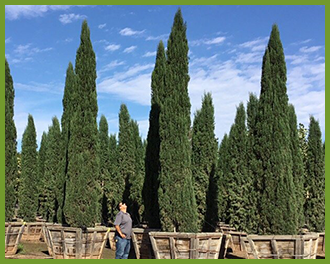 Italian Cypress
Italian Cypress
While searching for photos of Tuscany online you would be hard pressed to find a photo of the region that does not feature an Italian Cypress (Cupressus sempervirens 'Glauca'). These trees are found everywhere in Tuscany due to their many landscape applications. They can be planted in rows for maximum privacy, used to line a street or driveway, or they can be planted in the front of your home for a formal eye-catching entrance. The Italian Cypress that we offer at Moon Valley Nurseries is both drought and heat tolerant once established. Homeowners can expect the lush blue-green foliage to stay healthy and vibrant all-year long.
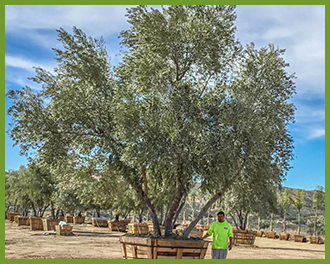 Fruitless Olive
Fruitless Olive
In no way can it be a Tuscan style backyard without an olive tree, one of the three core ingredients of the Mediterranean cuisine (the other two are grapes and wheat). At Moon Valley Nurseries, we offer fruitless olive trees (Olea europaea 'Wilsonii'), meaning that you do not need to be cleaning up the mess every year. The Clark County, LV, NV Department of Air Quality, has approved our "certified fruitless strain." This certification is especially important to our customers in Las Vegas, Nevada, and Phoenix, Arizona as fruit bearing olive trees are illegal in certain counties. This drought tolerant, medium-sized tree is perfectly suited for a Mediterranean Southwest garden style. Make this Fruitless Olive a focal point in your landscape and install nighttime landscape lighting in and around this tree to exhibit the interesting multi-trunk structure and eye-pleasing gray/green and silver foliage.
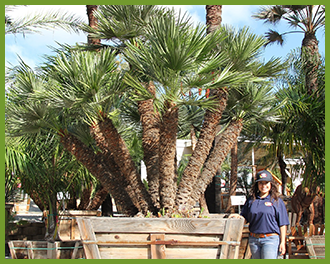 Mediterranean Fan Palm
Mediterranean Fan Palm
Nursery professional and area manager Sal offers his description of the Mediterranean Fan Palm (Chamaerops humilis):
"The reason why I like to sell the Mediterranean Fan Palm and why I like to plant them in many landscapes is that they are extremely hardy and very versatile palms. They are not too green and tropical, which allows them to fit into a lot of landscapes especially the Mediterranean style landscape. In addition, you get the added benefit of it being a dwarf palm. A lot of customers homes that we plant at do not have enough room to add a tall palm. The Mediterranean Fan Palm is a great solution because it will not grow tall. Additionally, this is one of the most hardy palms. I always suggest it to my friends and family because I want to plant something that will survive in their landscape. And finally, another great benefit is that these palms look really classy when we plant them in pots. The showy multi-trunk growth pattern on these palms really accentuates the bright colors on the pot."
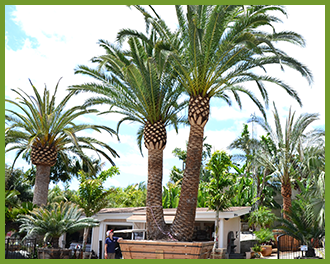 Canary Island Date Palm
Canary Island Date Palm
If you're looking for a palm that just says 'wow', look no further than the Canary Island Date Palm (Phoenix canariensis). These palms have a wide beautifully brown colored trunk accented by their pineapple cut crowns and their deep green, exotic looking fronds, that make this an extremely showy palm and focal point. These are gorgeous when lit up at night and work well by themselves or planted to line walk-ways, pools, sitting areas and driveways.
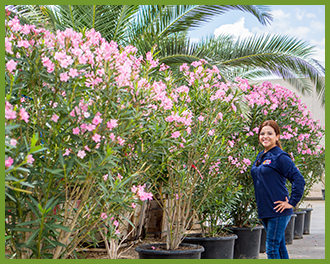 Oleander
Oleander
These trees just love the hot summer months, which makes them an ideal flowering tree or shrub for your landscape. The Oleander (Narium oleander) displays a long lasting bloom that comes in clumps of red, white, and pink. The blooms are vibrant may extend into the warmer winter months. Ideally planted in groups or rows, the Oleander is great for our customers who are seeking privacy hedges, area screens, and property borders because of its ability to keep a thick coat of dark green leaves throughout the year.
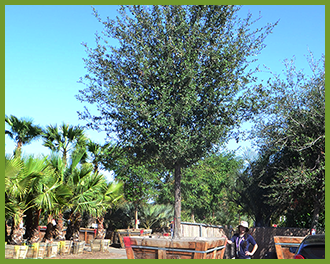 Live Oak
Live Oak
One of the most stunning trees on display, the Live Oak (Quercus virginiana) is a great choice for our region because of its adaptability, performance in the hot summer months, and its ability to grow in tough soil conditions. Its name is derived from its ability to “live” throughout the winter when other oaks are dormant or leafless. It has a wide canopy of dark green leaves and when planted in rows it can give your landscape a privacy wall or shade barrier that provides immense protection and beauty.
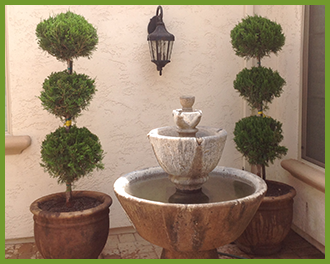 Juniper
Juniper
Landscaping with Juniper plants is easy and it offers many beautiful options and uses. Junipers vary in size and shape and they are evergreens with needle-like and/or scale-like leaves and come in many forms ranging from low-growing shrubs to tall, slender trees. Junipers are a great plant for filling in space fast and can be used as a ground cover, screen or vertical feature. They can also be planted in containers.
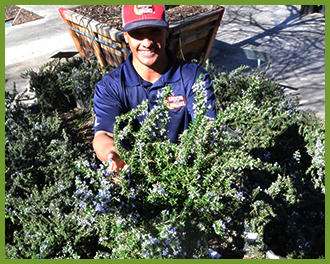 Rosemary
Rosemary
Rosemary (Romarinus officianalus) is a very hardy herbaceous shrub with many ornamental uses in all styles of landscaping. Easy to grow in a variety of soils, rosemary has been a mainstay of gardens for decades. Trailing variety can reach thigh high or be trimmed under 1 ft tall and allowed to spread as a ground cover. In raised planters and pots they will trail straight down the sides. Upright Rosemary can reach heights up to 5’ and more than 3’ across if desired. Very suitable for the sun or part shade Rosemary is very drought tolerant if watered deeply when young.
 Windmill Palm
Windmill Palm
A narrow and vertical palm, the Windmill Palm (Trachycarpus fortunei) is one of the most durable palms you can plant in your landscape. It thrives in intensely hot locations, requires minimal water and can handle periods of freezing weather with little or no damage. Commonly used as a stand alone or focal point, the Windmill Palm makes excellent accents to larger palms. It’s a neat, small scale fan palm that is great for use in small patios, narrow spaces, gardens, entryways, and any place in your landscape where a calming effect is desired. Looks fantastic around swimming pools, where mirror smooth water can reflect the graceful shapes of the Windmill Palm.
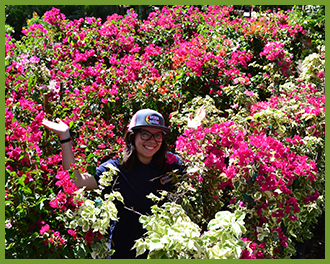 Bougainvillea
Bougainvillea
Bougainvillea (Bougainvillea spp.) come in three different varieties; bush form, vine form and Torch Glow, which is a more compact variety. Bougainvillea loves the heat and are an extremely drought tolerant plant once established. They are heavy bloomers throughout Spring and Fall. While extremely hardy in the desert heat, these plants can be damaged by hard frost and should be protected.

Submit a Comment